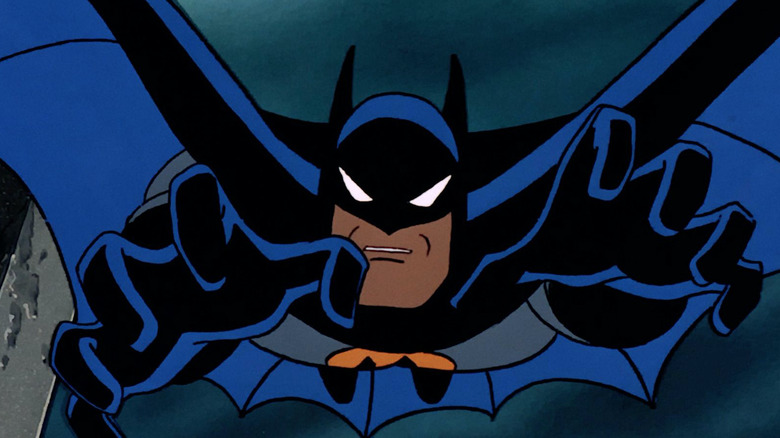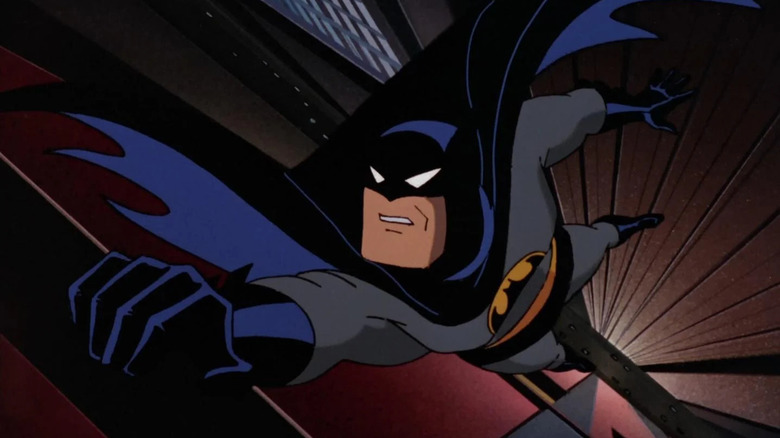Batman: TAS Would Have Been Set In The 1930s (If Bruce Timm Had His Way)
When Tim Burton was making "Batman" back in the late 1980s, he was approached by Warner Bros. about the possibility of including a few hot pop songs on the soundtrack. The studio's idea was to invite Prince to write several songs and to release a soundtrack record alongside an album of Danny Elfman's notable score. While Burton was a fan of Prince — and who isn't? — he didn't like the idea of including pop songs in "Batman." The studio, however, got their way, and songs like "Trust" and "Partyman" underscored several notable scenes in Burton's movie. Burton hated the result. He was once quoted as saying:
"It completely lost me. And it tainted something that I don't want to taint, which is how you feel about an artist. And actually, I liked his album. I wish I could listen to it without the feel of what had happened."
One needn't look very deeply to see why Burton was upset. Burton clearly worked very hard to construct a fantastical, expressionistic version of Gotham City that existed weirdly out of time. "Batman," for all its high-tech bat-gadgets, could have taken place anywhere from 1939 (when the first "Batman" comics were published) up to 1989. It was meant to look timeless. Pop songs by an active pop artist denote an exact time frame, and that betrayed the spirit of the thing.
Someone who keyed into Burton's efforts to make Batman timeless was animator Bruce Timm, the co-creator of the '90s show "Batman: The Animated Series." Borrowing Burton's expressionistic aesthetic, and folding in broadly designed, angular comic book-like characters, Timm's series also felt unstuck in history, as if Batman could make a passing reference to President Roosevelt and no one would bat an eye.
According to Timm, that was almost literally the case.
We need screens
When Bruce Timm was interviewed for Les Daniels' 1999 book "Batman: The Complete History," he mentioned that "Batman: The Animated Series" was, by his original intention, supposed to be set in 1939. The only real sticking point was the technology, as Batman was, after all, envisioned as being ultra-modern and having access to the world's best computers. The show's writers, in short, needed TV screens. Timm explained:
"If it had been up to me I would have set it literally in 1939. [...] But writers find it really hard to write stories without falling back on computer screens and things like that."
The resulting series did indeed feature an outsize bat-computer — the screen was about 20 feet wide — complete disk drives, analyzers, and other modern accouterments of the early 1990s. This was a conceit, of course, taken from both the comics and the 1966 "Batman" TV series, wherein Batman had no shortage of machines and analyzers to help him fight crime. With "The Animated Series," however, these high-tech widgets would be seen operating alongside old-fashioned-looking elevated trains, massive 1940s-style sedans (the kind that could fit four human bodies in the trunk), and characters that dressed in herringbone suits and wore hats.
Because of the modern conceits, Timm said that the show was actually granted a bigger budget, allowing him and his animators to more fully realize the show as they had pictured it. The show's score, by Shirley Walker, took cues from Danny Elfman's Stravinsky-like orchestral bombast, adding to the timelessness.
"Batman: The Animated Series" initially ran in primetime to attract an older audience, and eventually lodged itself into the minds of a generation. To this day, many consider it one of the best animated shows of all time.

